Download
Popular Posts
-
Gibboni and the Gibbon: At Stereo Exchange’s annual Spring High-End Audio Show, Roger Gibboni (left) of Rogers High Fidelity debu...
-
Hey, we were in earthquake country, the land from which Carole King may have received inspiration to write, "I Feel the Earth Move...
-
John Atkinson and Stephen Mejias were unable to attend the Munich High End Show this year, so the call went out to the editors of Ste...
-
A reader once noted that I tend to stick with the same reference gear longer than most reviewers. In addition to Audience's Au24e i...
-
Today, Sony announced an end to production on all MiniDisc players. In a few years, MiniDisc production will cease as well. I know w...
-
The name sounds perfect . It fits neatly next to those of Messrs. Leak, Sugden, Walker , Grant, Lumley, and others of Britain's...
-
The Enigmacoustics company from Irvine in California has become renowned for the self-energized, horn-loaded Sopranino electrostatic su...
-
With the introduction of Audio Alchemy's Digital Transmission Interface (DTI) more than three years ago, the company created an ent...
-
If it's rare to go to an audio show and hear most of a company's products set up properly in multiple rooms, it's rarer sti...
-
There's nothing like highlighted text from Stereophile brother Art Dudley to get a fellow writer's attention. Then again, so...
Market information
Blog Archive
-
▼
2013
(510)
-
▼
August
(31)
- Should Music Be Free?
- DSD Downloads
- Free Online Course on Beethoven's Piano Sonatas
- AB Analyzes His System
- Creek 4240 Special Edition integrated amplifier
- B.M.C. Phono MCCI phono preamplifier
- Steve Coleman and the Five Elements
- Payday Albums: 7/26/13 & 8/23/13
- Nothing More than Lights in a Box
- The Great Wall of China
- JBL 250Ti loudspeaker
- Symphonic Line Kraft 400 monoblock power amplifier
- CAS 2013: A Preliminary Evaluation
- CAS 2013 Day 3: Return to Terra Infirma
- CAS 2013 Day 3: Au Revoir, Trois
- CAS 2013 Day 2's Close: Irresistible and Noteworthy
- CAS 2013: Day 2 Moves On and Up
- CAS Day Two: The High and the Mighty
- CAS 2013 Day One: Scaling the Heights
- CAS 2013: Day One, Lots More Lobby
- CAS 2013: Day One, Poking Round the Lobby
- CAS 2013 Gets Underway
- Music Matters 2013—John Atkinson at ListenUp, Denver
- Nothing is Too Wonderful to be True
- The Fifth Element #80
- Record Sale at The Rodgers and Hammerstein Archive...
- Moderat: II
- Looking Forward: Matana Roberts' Coin Coin, Chapte...
- The 4th California Audio Show Starts Friday
- Schiit Audio Bifrost D/A processor
- Audiofly Headphone Sweepstakes
-
▼
August
(31)
CAS 2013: Day One, Poking Round the Lobby
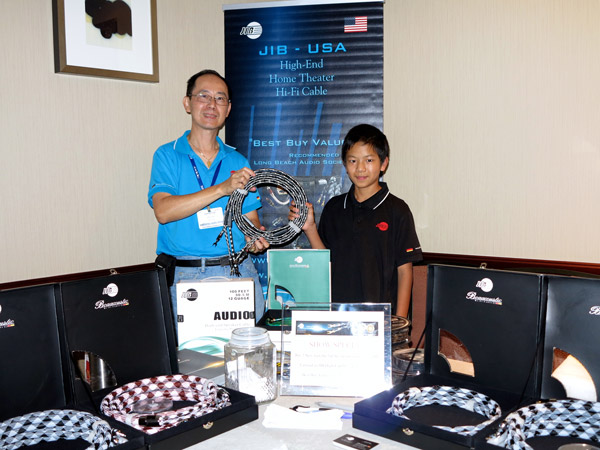
Yes, JIB almost always mounts passive displays. Instead, they offer a 90-day money-back guarantee, which should give folks plenty of time to discover what lies beyond their cables' eye-catching covers.

AudioVision San Francisco, one of the West Coast's major dealerships, sponsored three exhibits at CAS. Each was in a space considerably larger than their main San Francisco showroom.
Spaciousness, however, is not always an advantage when two displays are housed in acoustically damning perfect cubes. Thus, in the first room I entered, a few hard-to-tame resonance issues clouded an otherwise extremely musical presentation of a wonderful LP on which Tony Bennett and Bill Evans perform "The Days of Wine and Roses." Mastered by Steve Hoffman, and available from Analogue Productions, the performance was made all the more compelling by Audio Physic Classic 20 loudspeakers ($4490 to $4850/pair)—I don't think the Classical 10s, also in the room, were playing; Rega RP 6 turntable with Exact2 cartridge ($1990) or Rega RE3 turntable with Elys2 cartridge ($1095); Rega Aria phono stage ($1495), Regal Elicit-R integrated amp ($2999); MSR Acoustics Spring Traps ($899/each); Nordost Valhalla2 power cables ($999); Nordost Red Dawn speaker cables ($1040/pair), interconnects ($525/pair) and power cables ($365/each); Nordost Quantum Qb8 power distributor ($1399); Naim XS-2 integrated amp $2900), ND5-XS Network player ($3500), XP5 XS ($2800), and UnitiServe 2TB ($3800); Quadraspire Sunoko Vent 2T (approx. $2780); and Wadia Intuition 01 integrated amp/DAC ($7499).
Faring even better, despite being confined to St. James Infirmary, was Louis Armstrong. Somehow, the Doc cured his recording of resonance issues.
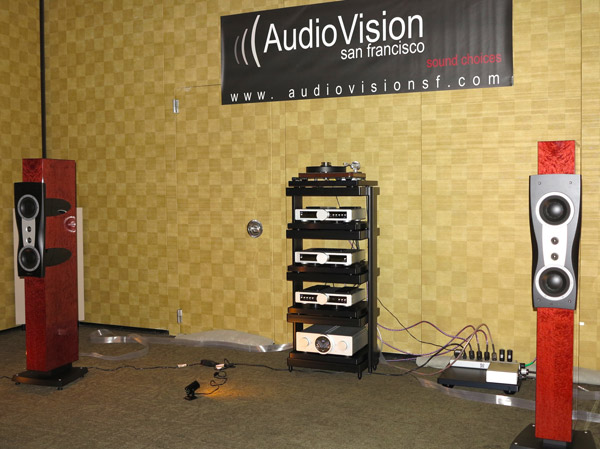
Mike Manousselis of Dynaudio made sure to tell me, as soon as I entered his AudioVision SF-sponsored room, that the radiation patterns of the Dynaudio Coincident C2 Signature loudspeakers ($15,000/pair) can even conquer the acoustic challenges of cubes because the speaker eliminates (neutralizes?) floor and ceiling reflections. On the first track of Patricia Barber's Smash, in the Mobile Fidelity SACD remastering, bass was rock solid, the voice had considerable height, and the large soundstage captivated. Bass was a mite insistent, but the overall gestalt of the presentation was quite beautiful.
Next I turned to San Francisco Symphony's live PCM-derived SACD of John Adams' Short Ride in a Fast Machine. The soundstage was huge, with images placed high, but the naturally bright recording was rendered a tad too bright, tinny, and metallic.
Making music possible were B.M.C.'s CS2 integrated amplifier ($7500) and BDCD C1.1. CD transport/player ($5990); HRS RXR audio rack ($4000-$7000 depending up size and shelves); Nordost Frey speaker cables (42925/pair), interconnects ($1460/pair), and power cables ($1680/each); Nordost Qb8 power distribution ($1400) and Quantum Qx4 ($2700). Where the brightness came from is anyone's guess.
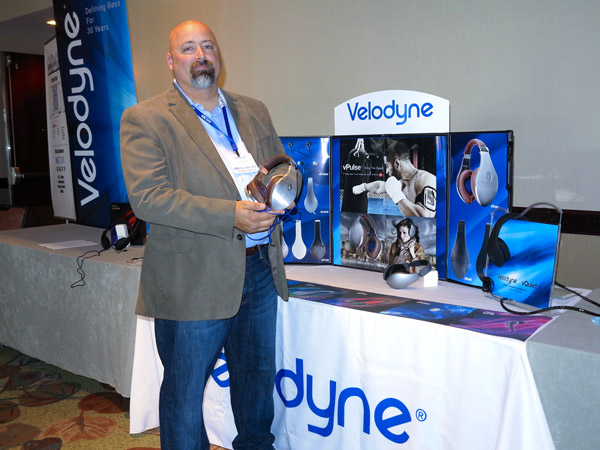
Positioned outside the merged ballrooms that together housed CAS' Headphone Meet, subwoofer champion Velodyne was letting people know that the company has risen off the floor to embrace the upper reaches of humankind. In other words, the're into cans. And while they have but one physical retailer so far, Velodyne's headphones are eminently available online.
The company's Nancy Tschirhart and Rob Morse explained that, as of September, seven models will be available. At the low end are the vFit and vPulse earbuds ($99 each), the VFit being a sporty version designed to withstand workout sweat and abuse. At the other end of the chain sings the vTrue ($399), with its forged aluminum frame, leather earcups, and 50mm drivers.
Playing through iTunes, I found a recording a Lady Gaga's "Poker Face" surprisingly easy on the ears. I also got off on an unedited master tape issue of Buddy Holly's "True Love Ways," whose soupy strings the vTrues transmitted with winning warmth. Bass was a little loose, but quite good otherwise.
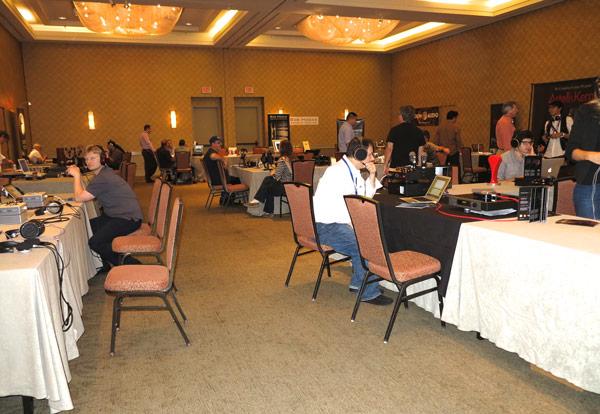
Thus hooked, I peeked into headphone meet. Realizing how easily I could get sucked in, to the detriment of everything else at the show, I resolved to return on the final day. Perhaps this reflects my personal bias, which favors loudspeaker listening. It also reflects the fact that I've had, for the last 20 years, first an apartment and then a house that have been able to accommodate large loudspeakers. As I prepare to leave the barrio of East Oakland for another house somewhere in the East Bay, perhaps I'd be wise to spend more time exploring cans.

Resolving to abstain, I instead came upon Mark Waldrep of AIX Records. Having forgotten to pack his copious catalog of surround sound Blu-ray discs before he drove up from Southern California, Mark was hawking his DVDs and HD Audio Sampler.
In addition to issuing five new recordings this year, Mark was especially excited about his recording of Terry Trotter, which came out late last year. "He's a treasure of jazz solo piano done with intelligence rather than flash," he said. Trotter, now in his 70s, has been an LA studio icon since his teens. While still young, he was invited to join Miles Davis' band, but declined because he neither wanted to move north to San Francisco nor risk immersion in the addictive drug lifestyle common to many jazz musicians of the era.
Instead, Trotter moved on to become, at one point, Natalie Cole's music director. "Not enough people know about him," Mark declared. Look for Trotter's I Play Piano AIX Records Blu-ray disc, on which you'll discover enough uncommon, slowly negotiated harmonic changes to leave you wanting more.
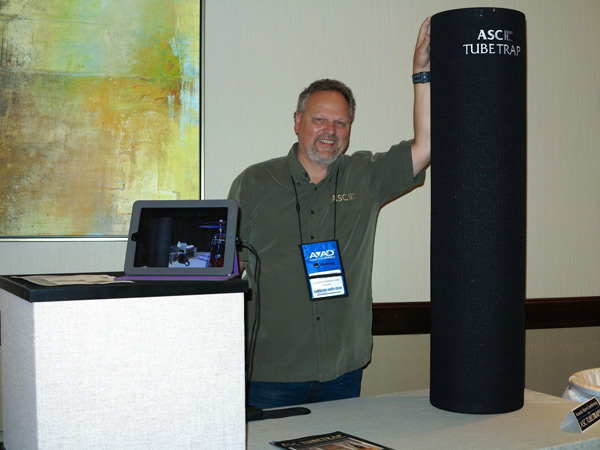
What you and thousands of other audiophiles probably don't want more of is booming, bloated, exaggerated, and otherwise errant bass. Hence, Chris Klein, one of the sponsors of CAS, drove enough ASC Tube Traps down from Eugene, OR to outfit 12 rooms at the show. By the time I encountered him Friday morning, only four remained, two of which he was using in his booth display. I soon encountered a number of exhibits that would have been wise to have snatched the other two.
Source : stereophile[dot]com


Comments[ 0 ]
Post a Comment